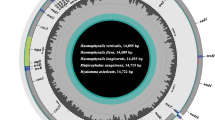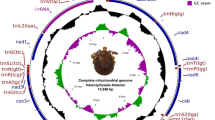Abstract
The paper investigated the life cycle of the hard tick Haemaphysalis doenitzi under laboratory conditions and its phylogeny based on mitochondrial 16S rDNA. The results revealed that the complete life cycle of H. doenitzi requires a mean duration of 109.6 days ranging from 91 to 137 days and the average prefeeding, feeding and premoulting periods of larvae, nymphs and females and the eggs hatching period are 18.7, 26.9, 38.9, and 25.1 days, respectively. In addition, the weight of engorged females is highly correlated with the number of egg masses laid (r = 0.936, P < 0.001). The female reproductive efficiency index and reproductive fitness index are 13.4 and 12.8, respectively. The mean weight of the engorged nymphs (2.77 mg) moulting to females is much higher than those (1.68 mg) moulting to males, which could be used as an index to predict sexes in this species. The ratio of male to female is 1:1.01. Moreover, multisequence alignments and phylogenetic tree constructed based on the mitochondrial 16S rDNA sequences suggest that H. doenitzi is genetically close to H. longicornis.




Similar content being viewed by others
References
Ahantarig A, Trinachartvanit W, Milne JR (2008) Tick-borne pathogens and diseases of animals and humans in Thailand. Southeast Asian J Trop Med Public Health 39:1015–1032
Ahmed BM, Taha KM EI, Hussein AM (2011) Life cycle of Hyalomma anatolicum Koch, 1844 (Acari: Ixodidae) fed on rabbits, sheep and goats. Vet Parasitol 177:353–358
Barker SC, Murrell A (2004) Systematics and evolution of ticks with a list of valid genus and species names. Parasitology 129:15–36
Chen Z, Yu Z, Yang X, Zheng H, Liu J (2009) The life cycle of Hyalomma asiaticum kozlovi Olenev, 1931 (Acari: Ixodidae) under laboratory conditions. Vet Parasitol 160:134–137
Chen Z, Yang X, Bu F, Yang X, Yang X, Liu J (2010) Ticks (Acari: Ixodoidea: Argasidae, Ixodidae) of China. Exp Appl Acarol 51:393–404
Chilton NB (1992) An index to assess the reproductive fitness of female ticks. Int J Parasitol 22:109–111
Dantrakool A, Somboon P, Hashimoto T, Saito-Ito A (2004) Identification of a new type of Babesia species in wild rats (Bandicota indica) in Chiang Mai Province, Thailand. J Clin Microbiol 42:850–854
Despins JL (1992) Effects of temperature and humidity on ovipositional biology and egg development of the tropical horse tick, Dermacentor (Anocentor) nitens. J Med Entomol 29:332–337
Doube BM, Kemp DH (1979) Notes on the tick Haemaphysalis (Ornithophysalis) doenitzi Warburton and Nuttall (Acarina: Ixodidae) in Australia. Aust J Entomol 18:169–170
Gladney WJ, Dawkins CC, Price MA (1977) Amblyomma inornatum (Acarina: Ixodidae): natural hosts and laboratory biology. J Med Entomol 14:85–88
Hoogstraal H, Wassef HY (1973) The Haemaphysalis ticks (Ixodoidea: Ixodidae) of birds. 3. H. (Ornithophysalis) subgen. n.: definition, species, hosts, and distribution in the Oriental, Palearctic, Malagasy, and Ethiopian faunal regions. J Parasitol 59:1099–1117
Hu R, Rowley WA (2000) Relationship between weights of the engorged nymphal stage and resultant sexes in Ixodes scapularis and Dermacentor variabilis (Acari: Ixodidae) ticks. J Med Entomol 37:198–200
Jongejan F, Uilenberg G (2004) The global importance of ticks. Parasitology 129:3–14
Labruna MB, Kasai N, Ferreira F, Faccini JLH, Gennari SM (2002) Seasonal dynamics of ticks (Acari: Ixodidae) on horses in the state of São Paulo, Brazil. Vet Parasitol 105:65–77
Labruna MB, Pinter A, Teixeira RHF (2004) Life cycle of Amblyomma cooperi (Acari: Ixodidae) using capybaras (Hydrochaeris hydrochaeris) as hosts. Exp Appl Acarol 32:79–88
Liu J, Liu Z, Zhang Y, Yang X, Gao Z (2005) Biology of Dermacentor silvarum (Acari: Ixodidae) under laboratory conditions. Exp Appl Acarol 36:131–138
Perret JL, Rais O, Gern L (2004) Influence of climate on the proportion of Ixodes ricinus nymphs and adults questing in a tick population. J Med Entomol 41:361–365
Robbins RG (2005) The ticks (Acari: Ixodida: Argasidae, Ixodidae) of Taiwan: a synonymic checklist. Proc Entomol Soc Wash 107:245–253
Teng KF, Jiang ZJ (eds) (1991) Economic Insect Fauna of China. Fasc 39 Acari: Ixodidae. Science Press, Beijing (in Chinese)
Tian Z, Liu G, Xie J, Yin H, Luo J, Zhang L, Zhang P, Luo J (2011) Discrimination between Haemaphysalis longicornis and H. qinghaiensis based on the partial 16S rDNA and the second internal transcribed spacer (ITS-2). Exp Appl Acarol 54:165–172
Troughton DR, Levin ML (2007) Life cycles of seven ixodid tick species (Acari: Ixodidae) under standardized laboratory conditions. J Med Entomol 44:732–740
Yano Y, Shiraishi S, Uchida TA (1987) Effects of temperature on development and growth in the tick, Haemaphysalis longicornis. Exp Appl Acarol 3:73–78
Yeruham I, Hadani A, Galker F (2000) The life cycle of Rhipicephalus bursa Canestrini and Fanzago, 1877 (Acarina: Ixodidae) under laboratory conditions. Vet Parasitol 89:109–116
Yu Z, Zheng H, Chen Z, Zheng B, Ma H, Liu J (2010) The life cycle and biological characteristics of Dermacentor silvarum Olenev (Acari: Ixodidae) under field conditions. Vet Parasitol 168:323–328
Zhang J, Chen Z, Liu J, Yang X (2006) Study on oviposition and egg development of three species of hard ticks (Acari: Ixodidae) under laboratory conditions. Chin J Pest Control 22:864–867 (in Chinese with English abstract)
Zheng H, Yu Z, Chen Z, Zhou L, Zheng B, Ma H, Liu J (2011) Development and biological characteristics of Haemaphysalis longicornis (Acari: Ixodidae) under field conditions. Exp Appl Acarol 53:377–388
Acknowledgments
This project was supported by the National Natural Science Foundation of China (30970406) and the Key Basic Research Project of Hebei Province (11965516D). The authors are very grateful to Jiagang Sun (Director of Animal Husbandry and Food Bureau of Cangxi County, Sichuan, China) for the help in tick collection.
Author information
Authors and Affiliations
Corresponding author
Additional information
Xuejie Chen, Zhijun Yu have contributed equally to this work.
Rights and permissions
About this article
Cite this article
Chen, X., Yu, Z., Guo, L. et al. Life cycle of Haemaphysalis doenitzi (Acari: Ixodidae) under laboratory conditions and its phylogeny based on mitochondrial 16S rDNA. Exp Appl Acarol 56, 143–150 (2012). https://doi.org/10.1007/s10493-011-9507-8
Received:
Accepted:
Published:
Issue Date:
DOI: https://doi.org/10.1007/s10493-011-9507-8




